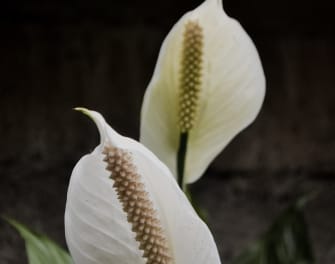Of all the houseplants you can bring home the Peace Lily is probably the easiest, in fact it tolerates average indoor conditions better than many other houseplants.

Blooms appear in early summer and last for weeks. The pale green spike turns white as it opens and protrudes above the dark green, glossy leaves. The leaves are string veined and arch away from the plant’s base, making this an attractive foliage plant when not in bloom. Keep its leaves dust-free by wiping them with a damp cloth.
No blooms? Plants that fail to bloom usually aren’t getting enough sunlight. Move your plants to a brighter location, but keep it out of direct sunlight. Got an older plant that refuses to bloom? If you haven’t divided it in several years (4-5 years), divide in spring. This is one of the few plants that blooms better after dividing it.
When caring for Peace Lily plants, remember that its leaves will indicate any problems. Brown leaf tips or yellowing leaves are likely caused by overwatering. Water thoroughly, but don’t allow the soil to get soggy. Leaves that lose their glossy appearance are likely not getting enough water.
Botanical Name: Spathiphyllum wallisii
Origin: South America
Height: Grows up to 3 ft. tall.
Light: Bright light but no direct sun. Will tolerate low light but may bloom poorly.
Water: Keep soil evenly moist. Be sure to choose a pot with a drainage hole to prevent soggy soil.
Humidity: Average room humidity, Peace Lily plants do not like dry air.
Temperature: Average room temperatures of 60-75 degrees F. (16-24 degrees C).
Soil: Any good quality potting mix, needs good drainage.
Fertilizer: Feed monthly spring through fall with a balanced liquid houseplant fertilizer, diluted by half.
Propagation: Division; this plant likes to be slightly pot-bound for best blooming. Divide every 4-5 years.
